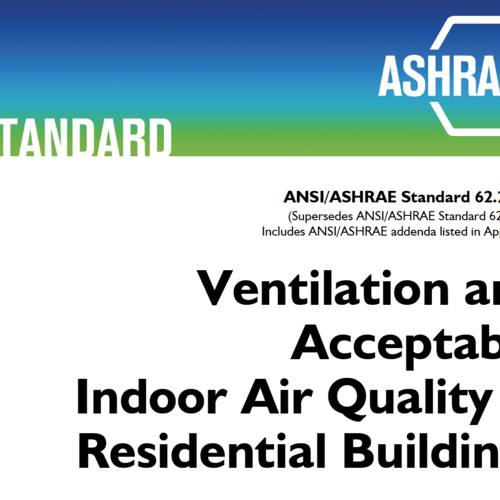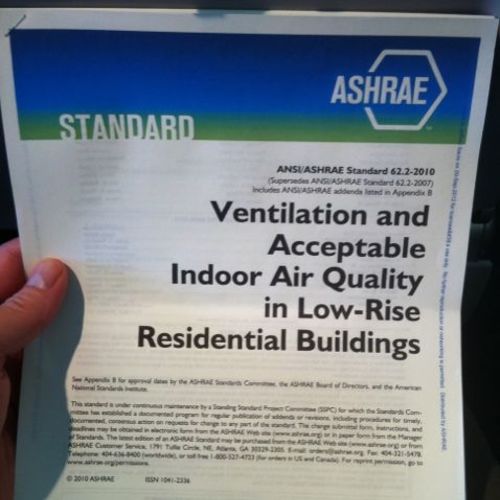Here is my rundown of the recent Affordable Comfort (ACI) conference in Detroit.
It was great to catch up with — or at least brush by — longtime industry friends, in the case of Allison Bailes of Energy Vanguard and Andy Frank of Sealed. It’s really cool that the industry is small enough you can become friends with even the big names.
For anyone considering going to ACI, it is worth it for the networking alone. Last year I had dinner with Chris Dorsi, one of the authors of my energy auditor textbook. I just asked if he was hungry. He was. So we ate. Try the same thing.
A contentious, one-sided debate
Allison Bailes of Energy Vanguard recently wrote a post on the Great Ventilation Debate. I thought he was very diplomatic about it, but I felt that the debate was actually more contentious and one-sided than he said.
For the uninitiated, ASHRAE 62.2-2013 is a new ventilation standard that requires generally higher ventilation levels for new homes. In other words, there must constantly be a fair amount of airflow out of (and consequently into) a home to provide continuous fresh air.
A committee of volunteers (poor guys, they really got shot at) designed the new standard, but Dr. Joe Lstiburek of Building Science Corporation strenuously disagreed with their findings. At several junctions, Joe looked so mad he could spit. I saw three main thrusts of his argument.
Too much moisture during the summer
First, much of his criticisms was based on the idea that the new standard required so much airflow that in hot humid climates too much moist outside air would be brought in in summer and in cold climates too much dry winter air would be brought in — decreasing comfort and increasing energy costs for both examples.
The point of the new, generally higher flow standard is to dilute bad stuff in houses like volatile organic compounds, carbon monoxide, and other contaminants. Joe posited that there are no epidemiological studies that show these things are actually bad for us, yet we know that the moisture problems described above are indeed a problem. So we are adjusting to fix something we aren’t sure of to the nearly guaranteed detriment of what we are sure of.
Balanced systems work better than exhaust-only systems
Second, there was the argument about balancing exhaust and supply air flows. Dr. Joe has come up with his own competing “standard” — one that gives more leeway to balanced systems that purposely allow for intake and exhaust in equal quantities (suck and blow in Joe-speak). The ASHRAE 62.2-2013 standard doesn’t treat balanced systems differently from exhaust-only (suck) systems.
I agree with Joe wholeheartedly on this. If you only provide for exhaust, where does the makeup air come from? Probably lousy places like basements, crawlspaces, and attics. The committee was trying to reduce costs here, but an alternative path requiring less ventilation for balanced systems would be good.
Politics or science?
Third, the standards were largely politically motivated, not based on sound science.
In my humble opinion, Dr. Joe landed by far the most punches in the debate. The only good hit back from the 62.2 committee was when Rick Karg of Residential Energy Dynamics asked Joe where his epidemiological evidence was. Joe did not have a direct answer to that. He did cite the experience in Canada where their ventilation standards, which are similar to the old standards, have not seen any ill health effects after 300,000 homes at 10 cfm. An imperfect answer, but as good as we actually have.
I posted the final score as Joe 25, Audience 5, 62.2 Committee 1. It was one of the most obvious debate wins I’ve ever seen.
Nate Adams is a recovering insulation contractor turned Home Performance consultant. His company, Energy Smart Home Performance, is located in Mantua, Ohio. Using a comprehensive design approach, he fixes client woes with a market-driven process that he hopes will lead to market transformation for our industry.
Weekly Newsletter
Get building science and energy efficiency advice, plus special offers, in your inbox.
















10 Comments
Common sense
One of the great benefits of knowing and learning from Joe for many years is that you get to know his passion and all his “Joe-isms”, which many of them gets into your head and they are hard to get rid of. But the best thing I’ve learn from him is that Building Science changes by the minute and he is not afraid to correct it or correct himself.
It’ll be hard for anyone to convince me that the same ventilation solutions we apply in Albuquerque or Cali works for Dallas, NOLA, Chicago or Boston. I don’t need a PhD to use common sense, and think that as AC and Heating solutions are not the same for different climate zones, so Ventilation solutions should be the different too. Last I heard, the V on HVAC is for ventilation, and works together!
If anything I get from these discussions is that there needs to be more research by ASHRAE, BSC and the BS (no pun intended) community, and I eagerly wait for some scientific answers; but until then, I’ve changed my design specs to include balanced ventilation to every house instead of supply only (cheaper and easier) just because it makes sense.
a quick question about ASHRAE standards in usa ..
is the new standard mandatory for every new construction in the whole us of a ?
Response to Jin Kazama
Jin,
No, ASHRAE 62.2 is not mandatory for new homes in the U.S. However, the 2012 IRC (not yet implemented in most jurisdictions) includes a requirement for mechanical ventilation in some homes; the required minimum ventilation rates in the new code are lower than the ASHRAE 62.2 rates. For more information, see An Overview of the 2012 Energy Code.
ok
So please explain what is the use for the ASHRAE standards then if not mandatory ?
I thought that this was the base of your building code.
Or is it more of a "proposed" advanced code similar to the "Novoclimat" you recently discussed about here in QC ?
Supply, Exhaust and Balanced.
The advice floating around gets a bit confusing. FHB just ran an article on ventilation where it ranked supply above exhaust for the reasons Nate mentions - that by pressurizing the house slightly it keeps anything nasty from entering the conditioned spaces, whereas exhaust only draws through the building assembly bringing pollutants along.
Fair enough from the occupants standpoint, but from the building envelope's perspective a bit of negative pressure will surely lead to less problems than positive. I see the advantage of a balanced system, but still don't see the clear cut advantage of supply over exhaust - especially if the exhaust system has passive supply vents.
Response to Malcolm Taylor
Malcolm,
Q. "I see the advantage of a balanced system, but still don't see the clear cut advantage of supply over exhaust."
A. Here's the traditional argument: with a supply-only ventilation system, you get better fresh air distribution (especially in bedrooms) than you do with an exhaust-only system.
Response to Jin Kazama
Jin,
Q. "What is the use of the ASHRAE standard then, if not mandatory?"
A. Standards define best practice in an industry, and are sometimes adopted by reference in building codes. They can also be referenced by architects when advising clients, or by lawyers when litigating.
Supply, Exhaust or Balanced
I understand the traditional arguments and the cost issues, including first costs, operating costs and the cost of energy penalties. Of course the level of required occupant oversight to keep the system operating as designed and the level of required maintenance are also variables to consider.
A few questions for Martin about other (somewhat traditional) arguments:
1. What is the current thinking on the theory that supply systems are better suited in hot humid climates because they pressurize the interior slightly and are therefore less likely to drive the moisture in outdoor air into envelope cavities, creating moisture issues?
2. And what is the current thinking on the similar theory that there is an advantage for exhaust systems in cold climates because they are less likely to drive warm moist air into the building envelope based on an assumption of slight depressurization of the conditioned space?
3. What is the experience using passive air inlets with exhaust systems to control the source of the fresh air? I can imagine that in milder climates this might be a very effective option.
Response to Armand Magnelli
Armand,
Many of the answers to your questions can be found in this article: Designing a Good Ventilation System.
Briefly, the airflow rates required for a ventilation system are quite low -- generally in the range of 40 cfm to 100 cfm. In most homes, these low air flow rates are overwhelmed by more powerful factors like the stack effect and wind. That's why the very slight pressurization from a supply-only system, and the very slight depressurization from an exhaust-only system, neither prevents envelope problems, nor is likely to cause envelope problems.
The best way to ensure that you don't have hidden moisture problems in your building envelope is to try to make your envelope as airtight as possible, and to properly manage the moisture on the exterior through good flashing practices, a ventilated rainscreen, roof overhangs, and proper grading.
Passive air inlets are not required unless your house is extraordinarily airtight.
Martin
I have no reason to doubt that in theory passive air vents aren't necessary with an exhaust only system, but I live in a not very tight house and whenever I turn on a kitchen or bath fan I can feel the air flow at the vent with my hand. Maybe that flow is dwarfed by the air being drawn in through numerous other sources but there sure is a difference between having a fan on and off.
Log in or create an account to post a comment.
Sign up Log in